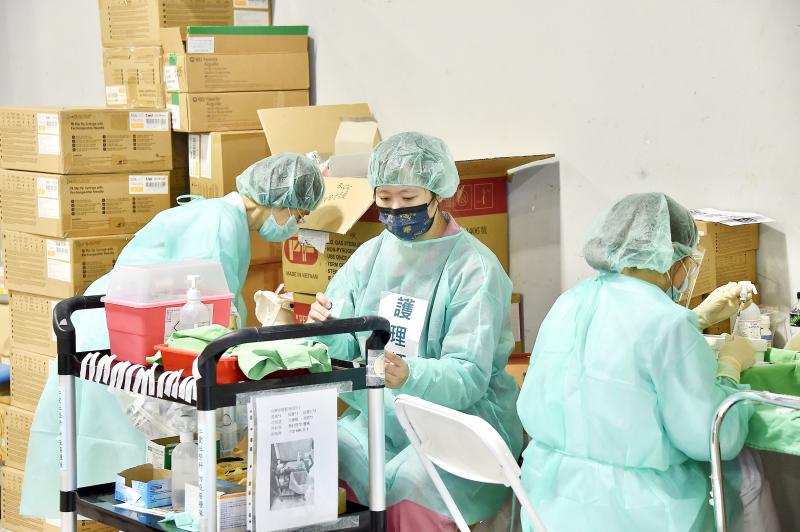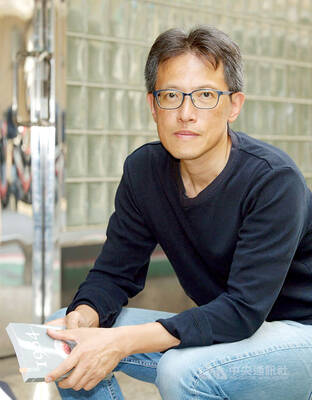A couple of years ago a friend got in touch with me. Her son, a nurse at a local hospital, needed a place to stay.
His hospital was technically in violation of the government regulations, which strictly apportion hospital beds based on an area’s population. Its operator, politically well-connected, simply ignored those rules and built the hospital, giving the area unneeded capacity. The twelfth-floor patient wards, superfluous, were used as makeshift dorms for the nurses.
NURSES: EXPLOITED SERFS

Photo: Tu Chien-jung, Taipei Times
Because the nurses were on-site even on their alleged days off or during sleeping hours, the hospital, perpetually short of staff, would ruthlessly yank the nurses out of bed to perform shifts. His mother said he was looking for a room in a place some distance from the hospital so he would no longer be effectively on call 24-7, working strings of days over 16 hours.
Foreigners often praise the cheap, plentiful medical care here, along with the National Health Insurance system, the latter one of the world’s best. Whenever something is cheap relative to income, like seafood or cellphones or vegetables or Uber, somewhere in the production chain there is a population of disposable, exploited serfs. In Taiwan’s hospitals, that is the nursing staff.
It is true that Taiwan’s hospital system is not for-profit. Instead, it is for-revenue. In that system, doctors prescribe drugs and treatments, and carry out surgeries and other interventions, and recommend expensive treatments, all of which generate revenues for the hospital. Nurses? Nurses are costs.
The factory model in Taiwan under which employees are viewed as costs is applied to all enterprises. Hospitals are no exception. Indeed, many of them are run by titans of industry who use them as revenue farms, harvesting the fruits of government subsidies.
The hospital system thus runs on the time-honored Taiwan gender principle under which exploited female workers at the bottom generate profits for the patriarch at the top.
As with factories in Taiwan, at many hospitals overtime laws are simply ignored and nurses are required to punch out and then continue working. This is so routinized that in one dramatic case that reached my ears a few years ago, a nurse miscarried at work and was required by the hospital to complete her shift before she could get a D&C.
“Most of them cannot take leave even when they are sick,” notes the study “The Relationship among Emotional Intelligence, Social Support, Job Involvement, and Turnover Intention — A Study of Nurses in Taiwan” (hereafter: “Nurses in Taiwan”) on why people quit being nurses. Promotion is slow.
According to “Psychological Work Environment and Suicidal Ideation Among Nurses in Taiwan,” the “poor psychological environment at work” of Taiwan’s nurses, resulted in one in seven nurses in the study having had suicidal thoughts.
NURSE SHORTAGES
The result is that though Taiwan graduates more nurses than it needs, and employed 185,000 of them last year, it remains at least 9,000 short even by its own stingy standards. One of the defining experiences of my work teaching at universities with nursing programs was my nursing students approaching me to pick my brains about what they should do now that they have decided not to be nurse.
The ongoing shortage means that, while the Ministry of Health and Welfare would like the number to be one nurse for every seven patients, the actual ratio is one to 12. The National Federation of Nurses Association pointed out in 2018 that from December 2013 to February 2018, 89.76 percent of local hospitals had difficulty recruiting nurses and the average vacancy rate was 5.57 percent. Most researchers give similar numbers, and almost all describe the shortage as “growing.”
HIGH TURNOVER
One aspect of the nursing shortage is the high turnover. Though numbers vary, in any given year probably 15-20 percent of nurses leave, with much higher numbers in the first few months. The turnover has all sorts of pernicious effects for patient care and nursing performance. As the “Nurses in Taiwan” paper observed about nursing turnover, just under 60 percent of nurses have a nursing certificate, while in Canada and the US the numbers are 93 percent and 83 percent, respectively.
The high nurse turnover helps hold costs down, since hospitals do not have to hand out as many raises and promotions. Hence, hospitals may make noises about it, but they take no concrete action.
The lack of nurses is subsidized by the Taiwanese themselves. When a person enters the hospital, family members are expected to stay with them to provide care, or to hire people to stand in for them. There are people who hang out by hospitals to fill that role. The system implicitly assumes that there are surplus family members who have time for that, but of course those days are long gone.
This means that family members must live through horrors they are neither emotionally nor professionally equipped for. My ex-wife, for example, had to care for her dying father in the hospital during his final weeks, when he had Alzheimer’s with dementia, and, not recognizing her, berated her for putting him in a concentration camp.
The government has attempted various measures to get nursing employers to change the conditions of the job, none of which have worked. From 2009 to 2014 it allocated billions to hospitals for that purpose. In 2014, the Taipei Times reported, nearly 500 medical institutions received funding, with only 49 percent hiring more nurses or increasing incentives and overtime pay. Fourteen percent did nothing, while 34 percent reduced their nursing staff.
Thus, the “nursing shortage” is one with all other labor issues in Taiwan, where workers constantly face petty, abusive bosses. As a post on one of the medical industry Facebook pages observed, Taiwan does not have a nursing shortage, what it has is a shortage of good working environments.
Pieces like this one generally recommend government action, but handing down money and setting new rules has had little effect. Worse, at present nursing unions and associations remain weak and ineffective, like almost all labor unions in Taiwan.
As the Taipei Times noted in a report two years ago, there are three unions, further dividing nurses. The one move the government could make that would have a powerful effect is to merge the nursing unions and require nurses to join the union, and then support nurses in strikes and other labor actions. Change would then occur quite rapidly, which might also open the door for labor action in other industries.
But whatever happens, the next time you’re in a hospital, be kind to the nurse. She’s undoubtedly had a hard day.
Notes from Central Taiwan is a column written by long-term resident Michael Turton, who provides incisive commentary informed by three decades of living in and writing about his adoptive country. The views expressed here are his own.

Three big changes have transformed the landscape of Taiwan’s local patronage factions: Increasing Democratic Progressive Party (DPP) involvement, rising new factions and the Chinese Nationalist Party’s (KMT) significantly weakened control. GREEN FACTIONS It is said that “south of the Zhuoshui River (濁水溪), there is no blue-green divide,” meaning that from Yunlin County south there is no difference between KMT and DPP politicians. This is not always true, but there is more than a grain of truth to it. Traditionally, DPP factions are viewed as national entities, with their primary function to secure plum positions in the party and government. This is not unusual

Mongolian influencer Anudari Daarya looks effortlessly glamorous and carefree in her social media posts — but the classically trained pianist’s road to acceptance as a transgender artist has been anything but easy. She is one of a growing number of Mongolian LGBTQ youth challenging stereotypes and fighting for acceptance through media representation in the socially conservative country. LGBTQ Mongolians often hide their identities from their employers and colleagues for fear of discrimination, with a survey by the non-profit LGBT Centre Mongolia showing that only 20 percent of people felt comfortable coming out at work. Daarya, 25, said she has faced discrimination since she

April 21 to April 27 Hsieh Er’s (謝娥) political fortunes were rising fast after she got out of jail and joined the Chinese Nationalist Party (KMT) in December 1945. Not only did she hold key positions in various committees, she was elected the only woman on the Taipei City Council and headed to Nanjing in 1946 as the sole Taiwanese female representative to the National Constituent Assembly. With the support of first lady Soong May-ling (宋美齡), she started the Taipei Women’s Association and Taiwan Provincial Women’s Association, where she

More than 75 years after the publication of Nineteen Eighty-Four, the Orwellian phrase “Big Brother is watching you” has become so familiar to most of the Taiwanese public that even those who haven’t read the novel recognize it. That phrase has now been given a new look by amateur translator Tsiu Ing-sing (周盈成), who recently completed the first full Taiwanese translation of George Orwell’s dystopian classic. Tsiu — who completed the nearly 160,000-word project in his spare time over four years — said his goal was to “prove it possible” that foreign literature could be rendered in Taiwanese. The translation is part of